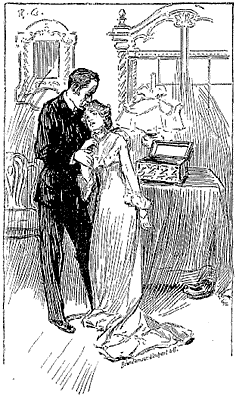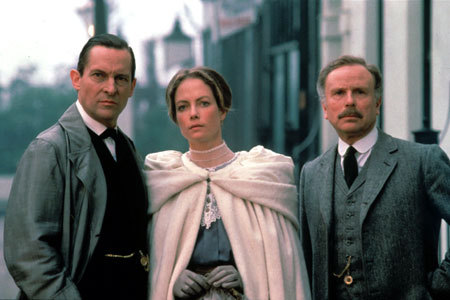“Miss Morstan entered the room with a firm step and an outward composure of manner. She was a blonde young lady, small, dainty, well gloved, and dressed in the most perfect taste. There was, however, a plainness and simplicity about her costume which bore with it a suggestion of limited means. The dress was a sombre grayish beige, untrimmed and unbraided, and she wore a small turban of the same dull hue, relieved only by a suspicion of white feather in the side. Her face had neither regularity of feature nor beauty of complexion, but her expression was sweet and amiable, and her large blue eyes were singularly spiritual and sympathetic. In an experience of women which extends over many nations and three separate continents, I have never looked upon a face which gave a clearer promise of a refined and sensitive nature.” (“The Sign of Four,” Chapter Two)
There is no denying it—Dr. John H. Watson was a marrying man. And in the Sherlock Holmes canon, he was married multiple times, although the exact number of times is up for debate. Two marriages are mentioned explicitly throughout the course of the stories, but some Sherlockian scholars have debated the existence of three—or even four—Mrs. Watsons. Indeed, the article “Counting Watson’s Wives,” by Brad Keefauver, posits the existence of six Mrs. Watsons. But of all those many wives, the first (as far as the reader is made plainly aware—Keefauver believes that she was actually Dr. Watson’s fifth wife) and best known is Miss Mary Morstan, who first appears at 221B Baker Street in The Sign of Four, as a client seeking to solve the mystery of her long-absent father and the strange pearls that have been sent to her in the post.
She is undeniably striking, an extraordinary woman, and the Doctor is immediately taken with her, as the preceding passage indicates. Over the years, her character has been portrayed by such actresses as Ann Bell, in the Peter Cushing adaptation of SIGN; Jenny Seagrove, in the Granada Television version; and most recently by Kelly Reilly, in the latest Guy Ritchie picture. In addition, author Molly Carr has penned two novels featuring Mary Watson in the role of consulting detective (with a supporting cast). At first Mary’s presence appears to be merely to fill the void that Dr. Watson has suddenly found in his life over the course of SIGN: “…that passing glimpse of a tranquil English home in the midst of the wild, dark business which had absorbed us” (SIGN, Chapter Seven). For many years—first in his time in Afghanistan and then in his partnership with Sherlock Holmes—Dr. Watson’s life has been fraught with violence, danger, and a host of other anxieties. It is not too much of a stretch to image that he would like a chance at a peaceful life; and Miss Mary Morstan, with her simple manners and sympathetic expression, seems like the perfect avenue of achieving that goal.
But placing limits upon Mary Morstan’s character would be doing her a disservice. It is certainly true, as has been discussed elsewhere, that she was more than capable of being a part of that comfortable domestic picture Dr. Watson seemed to so desire. Indeed, at the beginning of “A Scandal in Bohemia,” Watson famously comments on the state of his relationship with Sherlock Holmes: “My marriage had drifted us away from each other. My own complete happiness, and the home-centred interests which rise up around the man who first finds himself master of his own establishment, were sufficient to absorb all my attention…” The Watsons have clearly built a happy English household, tranquil and untroubled, but Mary was also more than capable of uprooting that domestic harmony.
In “The Boscombe Valley Mystery,” when Watson responds to Holmes’s summons with hesitation, it is Mary who says: “Oh, Anstruther would do your work for you. You have been looking a little pale lately. I think that the change would do you good, and you are always so interested in Mr. Sherlock Holmes’s cases.” To which Watson rightly responds: “I should be ungrateful if I were not, seeing what I gained through one of them.” It is possible that Mary also, never forgot how much she owed to Sherlock Holmes—not just her husband, but her peace of mind in finally knowing what became of her father. In “The Man with the Twisted Lip,” another story that opens on a scene of blissful domesticity, Mary makes no protest in sending out her husband to chase after Isa Whitney, at the Bar of Gold, in Upper Swandam Lane. She could not possibly have known that he would meet Sherlock Holmes while there, but she knows her husband and the adventurous circumstances under which they first met. Perhaps when Mary Watson told her husband he looked “a little pale lately,” what she really meant was that he had been looking “a little bored.”
In “The Boscombe Valley Mystery,” when Watson responds to Holmes’s summons with hesitation, it is Mary who says: “Oh, Anstruther would do your work for you. You have been looking a little pale lately. I think that the change would do you good, and you are always so interested in Mr. Sherlock Holmes’s cases.” To which Watson rightly responds: “I should be ungrateful if I were not, seeing what I gained through one of them.” It is possible that Mary also, never forgot how much she owed to Sherlock Holmes—not just her husband, but her peace of mind in finally knowing what became of her father. In “The Man with the Twisted Lip,” another story that opens on a scene of blissful domesticity, Mary makes no protest in sending out her husband to chase after Isa Whitney, at the Bar of Gold, in Upper Swandam Lane. She could not possibly have known that he would meet Sherlock Holmes while there, but she knows her husband and the adventurous circumstances under which they first met. Perhaps when Mary Watson told her husband he looked “a little pale lately,” what she really meant was that he had been looking “a little bored.”
Unfortunately, Mary was not to be a permanent fixture in Dr. Watson’s life. When Sherlock Holmes returns from the Great Hiatus, the reader also learns of Mary Watson’s passing. As Watson says in "The Empty House", “In some manner [Sherlock Holmes] had learned of my own sad bereavement, and his sympathy was shown in his manner rather than in his words. ‘Work is the best antidote to sorrow, my dear Watson,’ said he.” The cause of Mary’s death is not revealed, though some have posited that she died of tuberculosis, as the disease caused the death of Sir Arthur Conan Doyle’s first wife, Louisa. Others have suggested a death in childbed, as it was not uncommon, and some authors, such as Duane Swierczynski in The Crimes of Dr. Watson, have suggested that Mary’s sudden absence from Watson’s life was a cover for some more sinister behavior.
Whatever the cause, it is to be quite some time before Dr. Watson would remarry. But he does take another wife and in “The Blanched Solider,” Sherlock Holmes tells the reader: “The good Watson had at that time deserted me for a wife, the only selfish action which I can recall in our association. I was alone.” But this new Mrs. Watson is different. The reader never learns her name, or how she and Watson met. She certainly was not a client, or if she was, her case had been of little import or interest to the record. She does not comment, in one way or another, on her husband’s relationship with Sherlock Holmes and his involvement in his cases. And Sherlock Holmes does not arrive on her doorstep, seeking sanctuary. While prior to her passing, Mary Watson was mentioned in multiple stories (outside of SIGN) this new wife is barely mentioned at all, only in the briefest and snidest of remarks. This new wife is clearly no Mary Morstan. Brad Keefauver puts forth a unique and interesting theory regarding the identity of this final Mrs. Watson, which is available for perusal in his article.
Whatever the cause, it is to be quite some time before Dr. Watson would remarry. But he does take another wife and in “The Blanched Solider,” Sherlock Holmes tells the reader: “The good Watson had at that time deserted me for a wife, the only selfish action which I can recall in our association. I was alone.” But this new Mrs. Watson is different. The reader never learns her name, or how she and Watson met. She certainly was not a client, or if she was, her case had been of little import or interest to the record. She does not comment, in one way or another, on her husband’s relationship with Sherlock Holmes and his involvement in his cases. And Sherlock Holmes does not arrive on her doorstep, seeking sanctuary. While prior to her passing, Mary Watson was mentioned in multiple stories (outside of SIGN) this new wife is barely mentioned at all, only in the briefest and snidest of remarks. This new wife is clearly no Mary Morstan. Brad Keefauver puts forth a unique and interesting theory regarding the identity of this final Mrs. Watson, which is available for perusal in his article.
Mary Morstan was unique in that she was able to successfully balance all aspects of her life with Dr. John Watson—and by extension, her life with Sherlock Holmes. The circumstances of their meeting allowed Mary to be uniquely in-tune with not only what Watson wanted out of life, but also what he needed. She never shoved her husband headlong into danger, but occasionally she was certainly the gentle nudge that sent him out the door.
oOo
Check back here on Monday, August 29, for details on the latest blog contest and learn how you can win an assortment of Sherlock Holmes-related prizes.
“Better Holmes & Gardens” now has its own Facebook page. Join by “Liking” the page here, and receive all the latest updates, news, and Sherlockian tidbits.




It is hard indeed not to have a little twinge of jealousy when it comes to Mary Morstan. Married to the kindly compassionate and gentlemanly Dr. Watson and yet still occasionally in the orbit of Holmes and his cases. Sigh.....
ReplyDeleteI am personally partial to Jenny Seagrove. Ever since I saw her in the 1982 adaptation of A Woman in White as Laura Fairlie, I have thought she is a perfect embodiment (in her portrayals) of a style of womanhood, much admired, from an earlier era. As Mary Morstan, she brings the kind of strength she showed in another film, A Woman of Substance.
Thanks for giving Mary another well-deserved moment in the sun.
I too am partial to Jenny Seagrove - her performance was almost exactly how I imagined Mary would be.
ReplyDeleteIt's funny you chose this to write about; I just finished reading an article in the latest Baker Street Journal that put an interesting spin on the marriage of Watson to Mary Morstan. Have you read it?
@Lucy: Thank you for your kind comment! I often feel a little bit of jealousy too, although I did just read a short story called, "The Lost Boy," which offers a very bittersweet take on Mary's life. Jenny Seagrove is probably my favorite portrayal--she is lovely and elegant in a very womanly way. But Kelly Reilly's version had a little bit of spirit that was charming too.
ReplyDelete@KateM: Looks like Jenny Seagrove is quite popular as Miss Morstan! :-) And I haven't gotten my most recent Baker Street Journal! Our mail service is really unreliable, and he tends to deliver our periodicals in one large delivery whenever he feels like it. I've complained, but to no effect. :-(